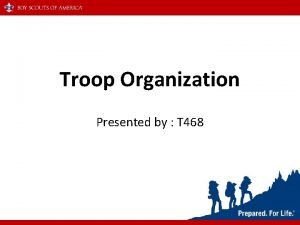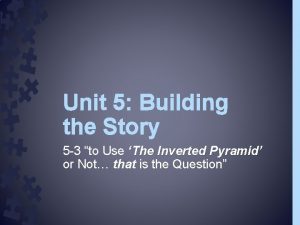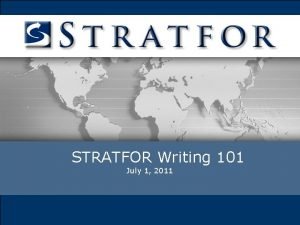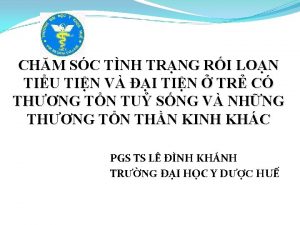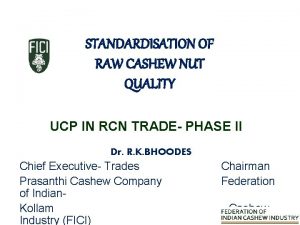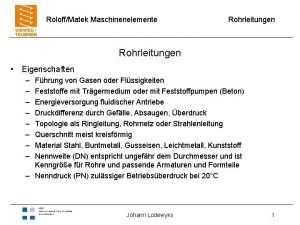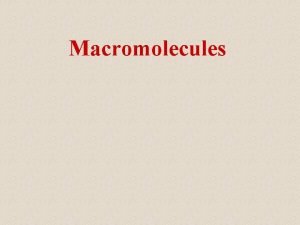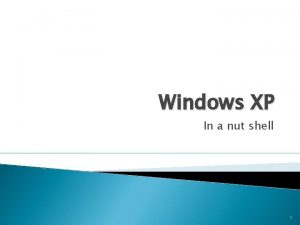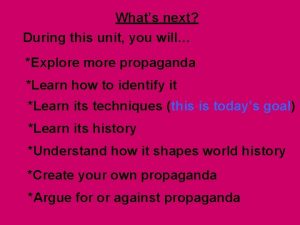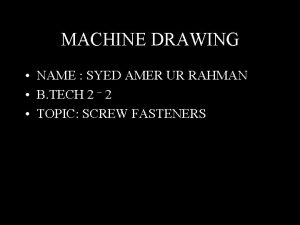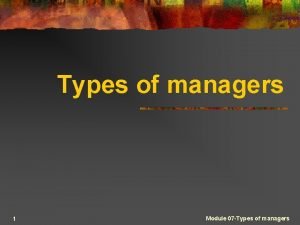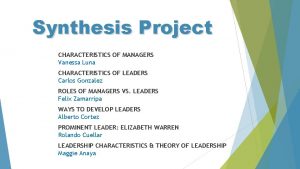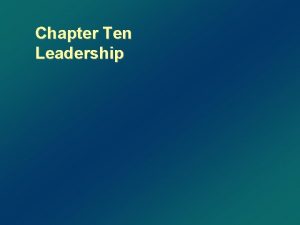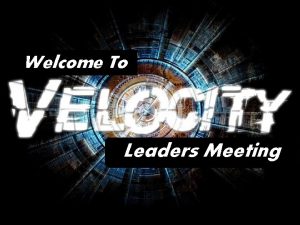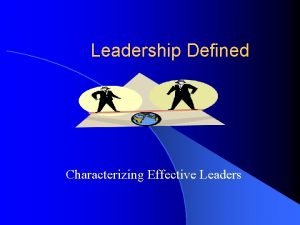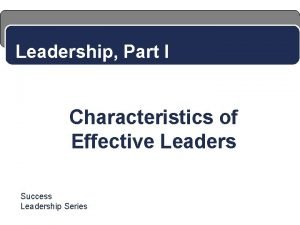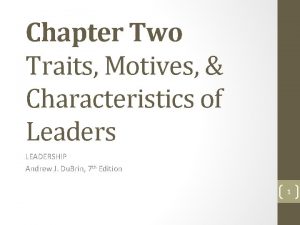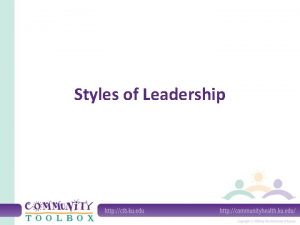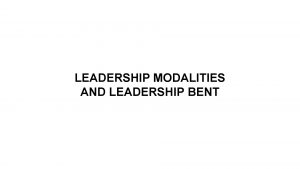LEADERSHIP NUT 468 CHARACTERISTICS OF LEADERS Managers Leaders
















































- Slides: 48

LEADERSHIP NUT 468

CHARACTERISTICS OF LEADERS

Managers & Leaders: SAME? ? ?

Manager Vs. Leader • The title of manager does not guarantee that the person who holds the title will be a good leader There is nothing inherent in the title of manager that guarantees that the person who holds the title will be a good leader • Managers who are not good leaders are often found within organizations

Manager Vs. Leader • Managers can effectively plan, organize & control - finances, production, purchasing etc. BUT have less success when working with staff • Leaders however in addition to being good managers are people oriented and work well with staff

Manager Vs. Leader • Leaders: o Demonstrate respect, concern & empathy for others o Share information o Decision making o Authority o Rewards o Trust o Vision

Manager Vs. Leader

How many types of leaders exist?

Formal Informal

Formal & Informal Leaders FORMAL INFORMAL Recognized by the organization Not recognized by the organization Endowed by the organization with a formal title Exhibits many of the characteristics of leaders but not endowed by the organization • Both formal and informal leaders must be considered • The formal leader should identify informal leaders in an organization, earning their respect and support should be a priority • Examples of informal leaders: senior employee, employees with greatest degree of technical expertise, …

Does everyone want to become a leader? Is every dietetic student’s dream scenario the following? Staff dietitian clinical nutrition manager

What are the characteristics of effective leaders?

Characteristics of Effective Leaders Intelligence Drive Motivation Integrity Self Confidence Expertise Other Characteristics

Characteristics of Effective Leaders Intelligence • The ability to acquire & retain knowledge • Respond quickly and successfully to a new situation Highly educated? Not all leaders are highly educated, nor should they be

Characteristics of Effective Leaders Drive • Major trait of effective leaders that describes their ambition, efforts, & risks they take in order to succeed • They need to achieve in order to feel successful • Ambitious and want to “fast track” their own careers • Willing to put effort into their work, to take risks and stick with a task until there are successful outcomes

Characteristics of Effective Leaders Motivation • A common trait in leaders essential to their realization of a vision or goal and part of their need to be a leader • Leaders have motivation toward a vision and want others to be able to see and follow that vision Leaders actively seek power effective leaders seek social power

Characteristics of Effective Leaders Integrity • An essential leadership characteristic seen in a leader’s reliability, fairness and credibility to others • Leader must demonstrate consistency between what is said and what is done • Trust must be earned

Characteristics of Effective Leaders Self-Confidence • Having enough confidence and security in oneself to make decisions, take risks and admit to making mistakes or saying I don’t know • Self confidence and assertiveness help managers who have these to move with ease in the leadership role • Demonstrates “grace under pressure”

Characteristic of Effective Leaders Expertise • Training and knowledge a leader must have in his or her specific area/field • Varies with the leader’s management position • Management skills actually become the technical skills for some jobs

Other Characteristics of Leaders Qualities that are not essential yet but they supplement & enhance the major leadership traits described • Charisma • Leaders reflect their degree of personal magnetism and their ability to attract others and to be followed – Examples such as Martin Luther King

Other Characteristics of Leaders • Creativity: • Find solutions and new ways to get things done – look beyond existing paradigms to get things done – not essential • Flexibility: • React to new changes and adapt well • Make quick judgments and adjustments –becoming an essential trait

Characteristics of Effective Leaders MANAGER/LEADER MANAGER/NONLEADER Innovates Administers Develops Maintains Focuses on people Focuses on systems and structure Inspires trust Relies on control Has a long-term view Has a short-term view Asks what and why Asks why and how Looks at the horizon Looks at the bottom line Is an original Is a copy DIFFERENCES BETWEEN MANAGERS WITH AND WITHOUT LEADERSHIP TRAITS Source: From Reinventing Leadership by Bennis and Townsend, p. 6 -7.

LEADERSHIP STYLES

Leadership Styles • Leadership is partly a learned behavior and partly a function of the personality of the leader • Most leaders use a variety of leadership styles which vary with the situation but with one of styles that stays predominant • Variation can be viewed on a continuum that ranges from autocratic to consensus management

Leadership Styles • Continuum of Leadership Styles: • Autocratic • Participative • Democratic • Consensus

Leadership Styles Example A physician may have an autocratic style when giving orders regarding the care of patients and having these orders followed without questions. When the same physician is asked to chair the fundraising efforts of a building committee for his favorite hospital, he may use a participative leadership style to enhance efforts of the committee

Autocratic Leadership • Also called directive or command-control leadership • Individuals whose primary style is autocratic are often labeled as “controlling” or “micro-managers” • Being used with less frequency than in the past- participative style is usually more effective • Best exemplified by the military model where orders are carried out when and as issued

Autocratic Leadership • Leader takes total control, assumes full authority and takes full responsibility for the area managed • Makes decisions, communicates them to others and expects them to carry out the decision without question • Men seem to have more success using that model than women

Autocratic Leadership • Works best when used by a proven leader who has earned the trust and support of subordinates • Some workers are selling their time and do not feel obligated or inclined to contribute their ideas Autocratic style is then a good fit • Unskilled workers may feel that it is the responsibility of the manager to tell the worker what to do and how to do it • These workers only want to do what they are told to and to receive fair compensation for their time and effort

Autocratic Leadership • Most effective when used either in a crisis or in a situation where there is a limited window of opportunity • This style is also used for making programmed decisions: one that is made routinely and can be made by one individual with information that is on hand: i. e. call in a replacement dietitian for one who has failed to report to work

Autocratic Leadership Advantages • Saves time • One person moves forward without the necessity of calling meetings and seeking the input of others • Decisions are made rapidly

Autocratic Leadership Disadvantages • Leader makes many decisions in a vacuum without taking advantage of the experience and insights of others on the management team • Alienate other members of the management team

Participative Leadership • One of the most widely used leadership styles • Manager gathers information necessary to take action and then seeks the opinions of colleagues and/or subordinates before doing anything • The manager still “sets the agenda” and makes the decision, but only after there has been input from others

Participative Leadership Advantages • Less likely to make errors relative to insufficient evidence or narrow perspectives • Subordinates feel that what they have to say is important and has been heard – gives them a sense of ownership within the organization – especially for middle managers or professionals • Manager with such style is likely to be rewarded with increased loyalty and support from staff

Participative Leadership Disadvantages • Managers are expected to use information and ideas that are generated, otherwise staff will learn to distrust the manager and will eventually stop participating in the process • Managers should be willing to share credit for success with the staff

Participative Leadership Disadvantages • Takes time and energy loss of a degree of efficiency • When time constraints or confidentiality are issues, staff participation in the management process may be limited or eliminated

Democratic Leadership • Decisions are made by the group rather than by the manager alone • Mainly used for policies and procedures, hiring of new staff, development of marketing and strategic plans and so on • Will NOT be used for all decisions: routine decisions will not be taken to the group, nor those that require immediate attention or those that involve confidential matters

Democratic Leadership Advantages • Increases the chance of reaching good decisions and attaining positive outcomes • When people agree with a decision, there is an increased likelihood that they will actively work to make its outcome successful partial ownership of the outcome

Democratic Leadership Disadvantages • More time consuming than participative leadership • If majority cannot agree on a course of action, no action can be taken at all • Some might not be in agreement, and they may (consciously or unconsciously) work against the implementation of the decision to justify his/her position sabotage

Consensus Management • Type most often associated with women managers • Requires that decisions or plans be made by a group and is based on ALL members working together until agreement is reached • Involves many people making compromises so that each member of the group can be accommodated because everyone must live with the decision

Consensus Management Advantage • Staff feel they are an integral and valued part of the team; each voice is heard in a safe environment and that what is said is important Disadvantages • Most time consuming of all styles • Sometimes the group never reaches consensus • To outsiders, the manager may seem unable to make a decision

Transformational and Transforming Leadership Transformational Leadership • Leadership type that transforms staff from rugged individuals into team players: provides individuals with the support they need to develop into workers who are willing and able to contribute their input to the management process applies to all but the autocratic style Transforming Leadership • One step further; it prepares the subordinates to take over management functions and perhaps even become the successor to the manager • Democratic and consensus leadership styles can be a part of transforming leadership

Self-Managed Teams • Work groups that function without a designated manager and involve the team members in decision making and in working together to manage themselves • If consensus or democratic models worked in the presence of a manager, it could work without an identified leader

Do self-managed teams really work? ?

Self-Managed Teams • Work well on projects if the team is established to address a problem or perform a task and knows that it will be disbanded when the project is over • Work well during transitional periods (between managers) • More difficult for self-managed teams to function in day-to-day operations acting manager (compensation? )

Self-Managed Teams • Why democratic/consensus managers are not hired: • Newly hired managers usually have many decisions to make in a short amount of time, especially when they are replacing a position that has been vacant for some time, or when the previous manager did not perform well • These styles require that a degree of trust be established between the leader and the staff before implementation

Self-Managed Teams • Dynamic changes: • If new member happens to be the new manager, this will lead to a major adjustment by the group and it will take time to accept the new leader • If new manager is from within the group, the new manager will already be familiar with the group processes and protocols and can move more quickly toward the consensus model

What type of leader are YOU? http: //www. nwlink. com/~donclark/leader/survstyl. html
 Boy scout troop committee organization chart
Boy scout troop committee organization chart Convert 240 k and 468 k to the celsius scale.
Convert 240 k and 468 k to the celsius scale. Cs 468
Cs 468 How managers become leaders
How managers become leaders Transactional leadership vs transformational leadership
Transactional leadership vs transformational leadership Situational leadership vs adaptive leadership
Situational leadership vs adaptive leadership Enthusiastic beginner disillusioned learner
Enthusiastic beginner disillusioned learner Qualities of a good student
Qualities of a good student Feature lead
Feature lead Nut graf examples
Nut graf examples Nut graph
Nut graph Ambihelical hex nut
Ambihelical hex nut Indian burial ground candy bar
Indian burial ground candy bar Nut graf
Nut graf Berat jenis nut kelapa sawit
Berat jenis nut kelapa sawit The drive which is used for metal cutting
The drive which is used for metal cutting Feature story
Feature story Ghana nut
Ghana nut Nut graph
Nut graph Nut graf examples
Nut graf examples Plumpy nut
Plumpy nut Klaudia kulpa
Klaudia kulpa Spintorq
Spintorq Edlanice
Edlanice Trophy nut orders
Trophy nut orders đếm số node lá trên cây
đếm số node lá trên cây Tật nứt đốt sống
Tật nứt đốt sống Nút lệnh print preview nằm ở đâu
Nút lệnh print preview nằm ở đâu Lọc là một công cụ của hệ qtcsdl
Lọc là một công cụ của hệ qtcsdl Raw cashew nut quality
Raw cashew nut quality The regulator diaphragm is often made from
The regulator diaphragm is often made from My grandpa eats honey nut cheerios periodically
My grandpa eats honey nut cheerios periodically Verschraubungsarten
Verschraubungsarten Botanical name
Botanical name What macromolecules make up a macadamia nut
What macromolecules make up a macadamia nut Cashew nut
Cashew nut Lanuage nut
Lanuage nut Windows nut client
Windows nut client Times 100 case studies
Times 100 case studies Maszyna do pisania nut
Maszyna do pisania nut Hexagonal nut
Hexagonal nut Nút lệnh font size có ý nghĩa gì
Nút lệnh font size có ý nghĩa gì The nut job awful movies wiki
The nut job awful movies wiki Lewis foundation bolt drawing
Lewis foundation bolt drawing Aheic
Aheic Leadership characteristics of jesus
Leadership characteristics of jesus Strategic planning definition
Strategic planning definition Difference between entrepreneur and businessman
Difference between entrepreneur and businessman Types of managers
Types of managers
